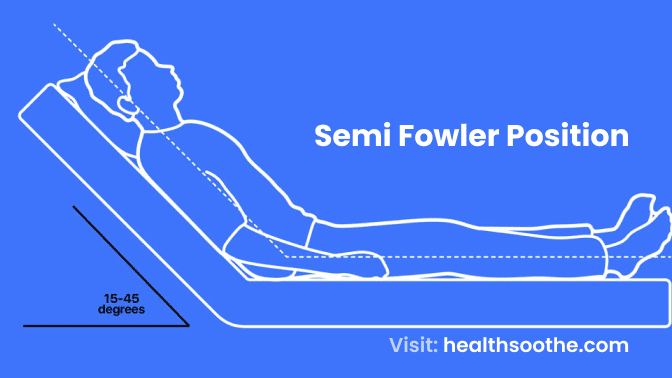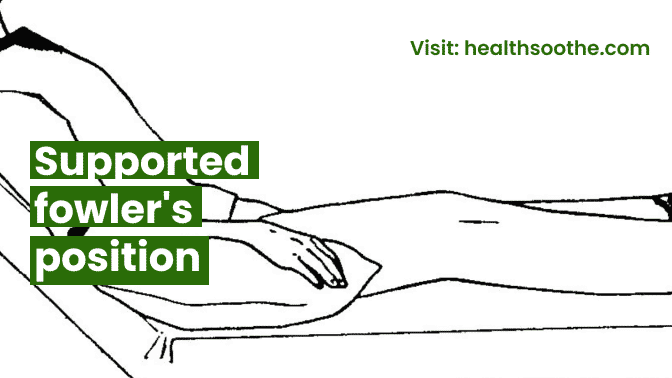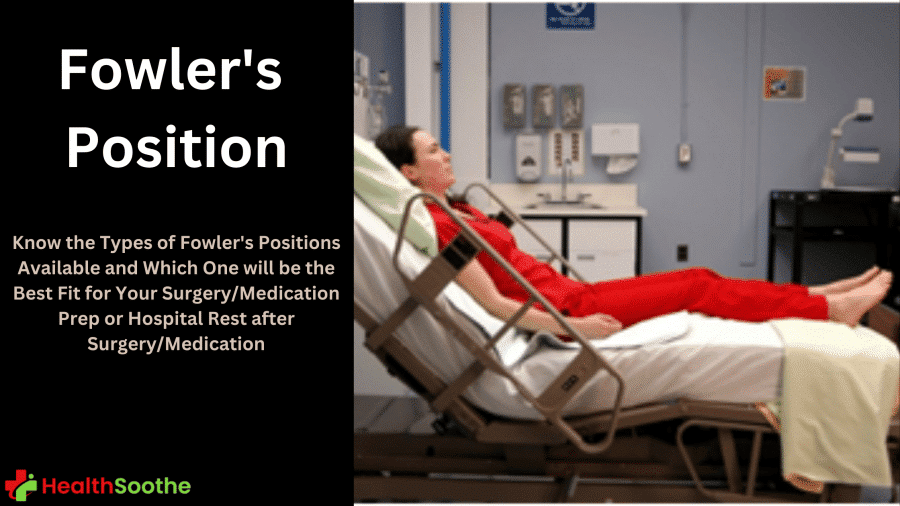The Semi Fowler Position is when a patient is placed on their back with their head and trunk lifted to between 15 and 45 degrees, usually in a hospital or nursing home, however, 30 degrees is the most common bed angle.
The elevation is lower than in Fowler's position, and it might involve raising the bed's foot to the level of the knee so that the legs can be bent.
Gravity pulling the diaphragm downward, allowing for expansion and ventilation, is helpful in promoting lung expansion in this position.
Additionally, it is advised to lower the risk of aspiration and regurgitation while gastric feeding.
The semi-Fowler's position is preferred during childbirth over the fullFowler's because it generally makes the mother more comfortable and reduces the need for analgesics and surgical interventions like caesarean sections or operative vaginal deliveries.
Examining the jugular veins also indicates the semi-Fowler's position.
The patient assumes Semi Fowler's Position typically lying on their back. The bed angle ranges from 30 to 45 degrees. The patient's legs could be bent or straight.
When a patient experiences breathing problems, is receiving breathing treatments or experiences drainage following an abdominoplasty, the semi-Fowler's position may be used.
The preferred position during childbirth to increase the mother's comfort is Semi Fowler's position because of the positioning. Additionally, compared to lying down, patients in this position have less nausea.
Fowler's position
Fowler's position, which is a common patient position in medicine, has the patient seated at a semi-sitting angle (45–60 degrees) with their knees open or closed.
Low Fowler, where the head is slightly elevated, and semi-Fowler, which indicates an upright position at 30 to 45 degrees, are used to indicate variations in the angle. When there is respiratory distress, this intervention is used to maximise chest expansion in order to promote oxygenation.
Fowler's position makes it easier for the abdominal muscles to relax and allow for better breathing. The Fowler's position relieves chest compression that results from gravity in immobile patients and infants.
When an infant exhibits signs of respiratory distress, Fowler's position is applied to improve uterine drainage in postpartum women and to increase comfort during eating and other activities. As it reduces the risk of aspiration, Fowler's position is also used when oral or nasal gastric feeding tubes have been placed.
Gravitational pull has a beneficial effect on peristalsis and swallowing.
When is Semi-Fowler's position used?
Similar uses for the Semi-Fowler's position as those of the regular Fowler's position include
- feeding
- lung expansion
- cardiac or respiratory conditions
- for patients with a nasogastric tube
Due to its unique benefits for the mother's comfort during childbirth, the Semi-Fowler position is also highly favoured.
What is semi-Fowler's position used for?
The positioning of the patient is essential for successful surgery. Whether a patient is resting comfortably in the emergency room or as an in-patient, the Fowler position is most frequently used.
Fowler's patient positioning, also known as the sitting position, is frequently used for shoulder and neurosurgical procedures. Low Fowler's Position, Semi Fowler's Position, and High/Full Fowler's Position are all variations of the Standard Fowler's Position.
Since gravity pulls the diaphragm downward in Fowler's position, it allows for greater chest and lung expansion, making it useful for a variety of patients who have breathing problems.
PATIENT POSITIONING CONSIDERATIONS FOR FOWLER’S POSITION
A general surgical table's built-in sections or the addition of surgical table accessories and positioning aids can be used in a variety of ways to achieve Fowler's position.
Beach chair positioners
Beach chair positioners and foam body positioners are typical surgical table accessories & positioning aids used when applying for Fowler's position.
In orthopaedic shoulder procedures, Beach Chair Positioners are most frequently used for High Fowler's positioning.
Beach chairs frequently have detachable left and right back sections that allow access to the patient's shoulder during surgery. It is also common for Beach Chairs to have lateral support that is employed to keep the patient positioned upright and restrict lateral torso movement during the rigours of upper extremity procedures.
Limb Positioners are commonly used in collaboration with Beach Chairs when employing High Fowler’s positioning in orthopaedic shoulder procedures.
Basic limb positioners can include arm and elbow positioners for neutral positioning of the patient’s operative arm for surgical site access or the non-operative arm(s) to get them out the surgeon’s way. More advanced limb positioners allow the surgical team to position the patient arms in unique, spatial positions that enable surgical site access to the shoulder across a spectrum of shoulder joint procedures.
OR staff can also employ advanced limb positioners for positions other than Fowlers; for instance, in lateral patient positions to enable suspended arm positioning for orthopaedic shoulder procedures.
Multi-position arm boards
Similar to basic limb positioners, multi-position arm boards allow for neutral positioning of the patient's operative arm for access to the surgical site or the non-operative arm(s) to clear the way for the surgeon to reach the target Similar to basic limb positioners, multi-position arm boards allow for neutral positioning of the patient's operative arm for access to the surgical site or the non-operative arm(s) to clear the way for the surgeon to reach the target anatomy.
Neurosurgical headrests and head positioners
In Semi-and Fowler's High Fowler's positioning, neurosurgical headrests and head positioners are frequently used to gain surgical site access to the patient's skull, facial, and neck anatomy.
To achieve the desired Fowler's position, the general table is frequently placed using native table sections (no Beach Chair is used). To facilitate immobilisation of the head and surgical site access, the native head section of the surgical table is frequently removed and the desired anterior or posterior positioning accessories are attached.
Gel and foam positioners
All of Fowler's positioning variations frequently employ gel and foam positioners. Headrest doughnuts, face masks for beach chairs, arm cradles, wedge positioners (for the legs or feet), heel and ankle cradles, and egg-crate foam sheets to protect or bolster key anatomical areas are common positioning aids that support the patient across Fowler's positions.
It is always advisable to perform pre-operative patient assessments to evaluate the patient's skin, body morphology, bony prominences, and any unique anatomical areas that call for special consideration during surgery.
Conclusion:
The Fowler's position, one of the most popular patient positions, offers better surgical exposure and enhanced breathing.
The surgical team should think about potential dangers and issues with the Fowler position, including:
- a decrease in the return of blood to the heart
- venous embolism
- air or gas inside the skull
- increased potential for airway loss
- an increased risk for nerve damage and facial edema



